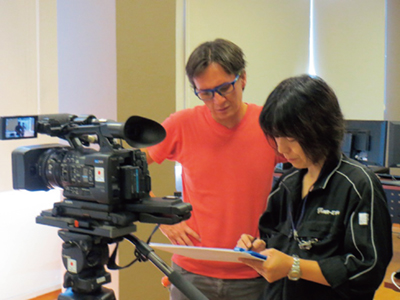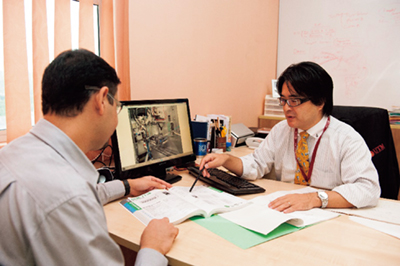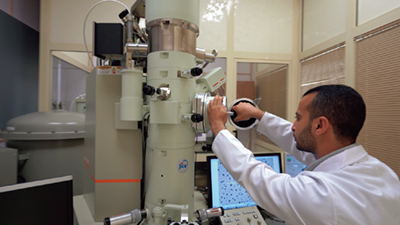(3) Promotion of Information and Communications Technology (ICT), Science, Technology, and Innovation, and Research and Development
The dissemination of Information and Communications Technology (ICT) (Note9) contributes to the upgrading of industry, improvement of productivity, achievement of sustainable economic growth, as well as addressing issues related to medical care, education, energy, environment, disaster risk reduction and other social issues in developing countries. Furthermore, the utilization of ICT improves their democratic foundation by encouraging information disclosure by governments and establishing broadcasting media. In this way, ICT is extremely important for strengthening civil society through enhanced convenience and improved services as well as for quality growth.
●Japan’s Efforts
Information and Communications Technology (ICT)

A local technical staff receiving instruction regarding machinery for training on digital terrestrial television broadcasting provided through general cultural grant assistance at the Latin American International Center for Superior Communication Studies in Ecuador (Photo: JICA)
In 2017, Japan formulated the Playbook for Investment in “Quality ICT Infrastructure” for ICT policymakers and procurement managers of the respective countries and regions in order to promote quality infrastructure investment in the field of ICT, with the aim of eliminating the ICT disparities that exist between countries and regions, and to help improve the quality of life of all people.
Moreover, Japan actively offers assistance centered on the establishment of communications and broadcasting equipment and facilities in developing countries, and the introduction of the technology and systems they require, and relevant human resources development. Specifically, Japan makes proactive efforts to provide comprehensive support for the overseas promotion of Integrated Services Digital Broadcasting-Terrestrial (ISDB-T), * which is also an effective means for boosting Japan’s economic growth, in the areas of maintenance, personnel and systems. ISDB-T is being spread in Latin America and the Caribbean, Asia, and Africa, and Angola also decided to adopt it in March 2019. As of December 2019, it has been adopted in a total of 20 countries. (Note10) A JICA training program is conducted every year for countries adopting or considering ISDB-T to promote the spread and introduction of ISDB-T overseas. In order to increase the adoption of ISDB-T in other countries, the Ministry of Internal Affairs and Communications (MIC) is also promoting assistance that offers ICT solutions to resolve social issues by way of dialogues and joint projects with partner governments.
MIC also contributes in the field of overseas deployment of ICT for disaster risk reduction. Japan’s ICT for disaster risk reduction makes it possible to collect, analyze, and distribute disaster information in an integrated manner, allowing detailed information to be communicated swiftly and infallibly at the community level, including to residents. Japan will continue to cooperate in the field of overseas deployment of ICT for disaster risk reduction and thereby aim to contribute to increasing the disasterreduction capabilities of developing countries (see “Cooperation in Disaster Risk Reduction” for more information on disaster risk reduction).
In addition, Japan actively carries out projects in colllaboration with international organizations. Japan works with the International Telecommunication Union (ITU), * a specialized UN agency that is responsible for telecommunications and ICT, to provide a variety of development assistance in the fields of telecommunications and ICT to developing countries.
At the Study Group meeting of the ITU Telecommunication Development Sector (ITU-D), which was held in October 2019 in Switzerland, Japan led the holding of workshops on new communications technologies for medical ICT. Japan provided introductions on the outcomes of the remote healthcare applications demonstration test utilizing 5th generation mobile telecommunications networks (5G), a fee-setting mechanism based on the users’ intent to pay for remote medication, and pathology diagnoses and healthcare systems utilizing artificial intelligence (AI), which were highly praised. Japan also introduced its own good practices in areas such as smart society, disaster mitigation ICT, environmental ICT, digital broadcasting, and accessibility at the ITU-D Study Group meetings in March and October 2019, and is proactively contributingto the information sharing between countries, including developing countries.
In the Asia-Pacific region, the Asia-Pacific Telecommunity (APT), * an international organization specialized in the field of ICT, contributes to the balanced development of the telecommunication services and information infrastructure in the region. The APT hosts a ministerial meeting once every five years to further strengthen regional cooperation to support the advancement of ICT in the Asia-Pacific region, and issues a joint statement setting the medium-term direction of ICT initiatives. 2019 was the 40th anniversary of the APT, and the APT Ministerial Meeting was held in Singapore as a commemorative event. During the meeting, the shared vision to promote digital transformation in the region was unanimously adopted.
In order to promote capacity building (human resource development), which is one of the priority areas under this shared vision, Japan finances a number of training programs conducted by APT every year. In 2018, eight training programs regarding issues such as broadband networks and cybersecurity were implemented, and were attended by around 100 people from the member states. During the programs, the trainees studied Japanese technology through classroom learning and facility visits, and are now utilizing this experience for the development of their own countries’ ICT. In addition, Japanese companies’ expansion into the region is also expected through introducing Japanese technology systems in the Asia-Pacific region.
Furthermore, in the Association of Southeast Asian Nations (ASEAN), ICT was identified as a key driver in ASEAN’s economic and social transformation under the blueprints adopted at the ASEAN Summit in November 2015 that provide new indicators leading up to 2025. Also, at the ASEAN Telecommunications and Information Technology Ministers (TELMIN) Meeting held in the same month, “The ASEAN ICT Masterplan 2020 (AIM2020)” that serves as ASEAN’s ICT strategy towards 2020 was formulated. Moreover, with regard to the issues of cyber-attacks that have become key concerns of countries in recent years, Japan and ASEAN have agreed to further strengthen their cooperation in the information security field.
Given this context, the basic assistance policies made by the relevant ministries and agencies to strategically and efficiently provide all-Japan support for capacity building in the cyber security field in developing countries were reported to the Cybersecurity Strategic Headquarters in 2016. Specific initiatives include the establishment of the “ASEAN-Japan Cybersecurity Capacity Building Centre (AJCCBC)” through the Japan-ASEAN Integration Fund (JAIF), and the cybersecurity training based on the Japan-ASEAN Technical Cooperation Agreement (see “Cyberspace” for details).
Promoting Science, Technology and Innovation, and Research and Development
As a major program for Japan’s science and technology-related assistance, the Science and Technology Research Partnership for Sustainable Development (SATREPS) program, * which links ODA and the science and technology budget, was launched in 2008, and by FY2019, 145 joint research projects in 51 countries around the world have been adopted (see also “Master Techniques from Japan to the World”).
Furthermore, based on cooperation for human resources, Japan is developing networks among the next-generation by strengthening assistance for overseas engineering universities.
In Asia, Japan provides support to the Malaysia-Japan International Institute of Technology (MJIIT) by purchasing equipment and supplies for education and research as well as developing curriculums. Japan also collaborates with 27 universities and two research organizations in Japan to extend cooperation for establishing curriculums, dispatching Japanese faculty, and other objectives. In addition, Japan provides contributions to the Asian Institute of Technology (AIT) located in Thailand, one of Asia’s leading graduate schools offering Master’s and Ph.D. programs at the School of Engineering and Technology, the School of Environment, Resources and Development, and other faculties. In particular, Japan is providing scholarships to students studying remote sensing (satellite image analysis) in courses taught by Japanese instructors, and contributes to human resources development in this field, which constitutes the crux of the space industry development in the Asian region.
In Egypt, Japan supports the Egypt-Japan University of Science and Technology (E-JUST), a public university based on the concept of “graduate school, research-centered, pragmatic, and international-standard education for a small number of students,” drawing on the features of Japanese-style engineering graduate school education. With the cooperation from universities in Japan, in addition to providing support for the operation of graduate schools and departments, such as the introduction of practical engineering education and Japanese-style laboratory education, Japan also supports the acceptance of exchange tudents from African countries, and contributes to industrial and science and technology human resources development in Africa and the Middle East.
Furthermore, Japan conducts a program to spread Japanese companies’ technologies that are useful for the socio-economic development of developing countries. This program is expected to lead to the spread of Japanese private companies’ advanced technological capabilities and diverse expertise in partner countries.

A Japanese teacher giving instructions at the Malaysia-Japan International Institute of Technology (Photo: JICA)

Conducting an experiment using research equipment provided by the Government of Japan at E-JUST
- *Heavily Indebted Poor Countries (HIPCs)
- 39 developing countries, mainly from the Africa and East Asia regions, that are poor and have heavy debt burdens, and that are applicable for the Enhanced HIPC Initiative, a framework to provide comprehensive debt relief.
- *Integrated Services Digital Broadcasting – Terrestrial (ISDB-T)
- ISDB-T is a terrestrial digital broadcasting system that was developed in Japan. Its functions, such as emergency alert broadcast, TV reception on mobile terminals, and data broadcasting, give the system advantages in disaster response and the provision of diverse services.
- *International Telecommunication Union (ITU)
- ITU is a UN specialized agency, which covers the fields of telecommunications and broadcasting (HQ: Geneva, Switzerland; 193 member states). To ensure that people around the world are able to make use of telecommunications technologies, ITU organizes the following: (i) international allocation of radio frequencies used in mobile phones, satellite broadcasting, and other technologies, (ii) international standardization of telecommunications technologies, and (iii) support for development in the field of telecommunications in developing countries.
- *Asia-Pacific Telecommunity (APT)
- APT is an international telecommunication organization established in the Asia-Pacific region in 1979, made up of 38 member states in the region. Aiming for a balanced development of telecommunication services and information infrastructure in the Asia-Pacific region, it implements human resources development through training courses and seminars, and coordinates regional policies on standardization, wireless communications, and other telecommunication issues.
- *Science and Technology Research Partnership for Sustainable Development (SATREPS)
- →See also “Master Techniques from Japan to the World”
- Through the collaboration of Japan’s advanced science and technology and ODA, SATREPS is an initiative to conduct research to solve global issues relating to the environment and energy, bio-resources, disaster prevention and mitigation, and infectious diseases. Under this program, research institutes both in developing countries and Japan work together to conduct international joint research with the following objectives: 1. Strengthening international science and technology cooperation, 2. Acquiring new expertise and technologies that will lead to resolving global issues, and using these to create innovation, and 3. Capacity development. (Note11) The Ministry of Foreign Affairs (MOFA) and JICA, in collaboration with the Ministry of Education, Culture, Sports, Science and Technology (MEXT), the Japan Science and Technology Agency (JST), and the Japan Agency for Medical Research and Development (AMED), provide support to research institutes and researchers in Japan and partner countries.
- Note 9: ICT is an Abbreviation for Information and Communications Technology. It is a technology that integrates computers and other information technology with digital communication technology, as represented by the Internet and mobile phones.
- Note 10: The 20 countries are Japan, Brazil, Peru, Argentina, Chile, Venezuela, Ecuador, Costa Rica, Paraguay, the Philippines, Bolivia, Uruguay, Botswana, Guatemala, Honduras, Maldives, Sri Lanka, Nicaragua, El Salvador, and Angola (as of December 2019).
- Note 11: Enhancing the independent research and development capacity, building sustainable activity systems which contribute to resolving challenges of developing countries, as well as conducting human resources development and establishing networks between Japan and developing countries for the future through international joint research.
